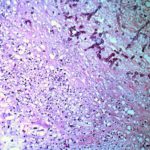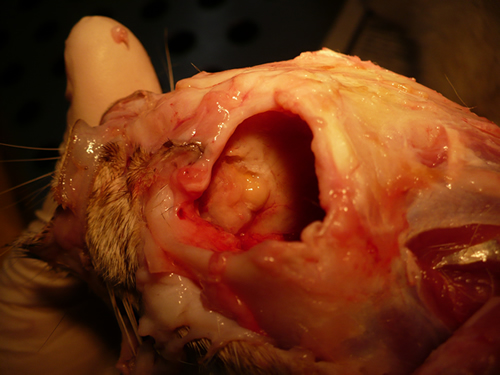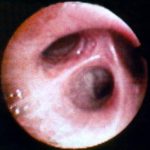Date: 26 November 2013
Nasal, sinus and orbital aspergillosis in a cat. The left nasal cavity and sinus were full of pus and debris and there was severe bone erosion from the nasal cavity into the rostromedial orbitthrough which pus was protruding
Copyright:
(Kindly provided by Martin L. Whitehead, BSc, PhD, BVSc, CertSAM, MRCVS & Peter W. Kettlewell, BVSc, MSc, MRCVS. Chipping Norton Veterinary Hospital, Albion Street, Chipping Norton, Oxon, OX7 5BN.)
Notes:
History : Nasal aspergillosis is relatively common in dogs but rare in cats. Our veterinary hospital in Oxfordshire was recently presented with a 13-year old female Burmilla cat with a history of left-side unilateral nasal discharge, a watery left eye with slight blepharospasm, occasional ‘twitching movements’ of the head, weight loss, inappetance and depression. Clinical examination was unremarkable except for left-side mucopurulent nasal discharge, left-side mild serous ocular discharge, and a soft subcutaneous swelling over the left frontal sinus. Haematology, blood biochemistry and urinalysis revealed diabetes mellitus but was otherwise unremarkable. Radiography under general anaesthesia revealed a diffuse soft tissue density within the left nasal cavity and left frontal sinus. Rhinoscopy revealed mucopurulent discharge on the left side but was otherwise unremarkable. Aspiration of the swelling over the left frontal sinus produced pus and this abscess was lanced and flushed. The frontal sinus was trephined and the sinus and nasal cavity flushed with saline. Tests for feline immunodeficiency virus and feline leukaemia virus and serology for Aspergillus were not carried out. The cat was started on insulin, ibafloxacin (Ibaflin, Intervet) and meloxicam (Metacam, Boehringer). Cytology of the material flushed from the frontal sinus and nasal cavity revealed fungal hyphae consistent with Aspergillus species and culture of this material yielded growth of a fungus which was morphologically similar to A. candidus (Awaiting molecular typing results). The cat was then started on oral itraconazole (Itrafungol, Janssen) 10 mg/kg p.o. SID. The abscess over the rostral frontal sinus did not heal and a second abscess appeared over the nasal bone just dorsal to the nose. Infusion of the frontal sinus and nasal cavity with topical antifungal medication was discussed with the owners, but as the cat was deteriorating they requested euthanasia. On post-mortem examination the right nasal cavity, frontal sinus and orbit were unaffected. The left nasal cavity and sinus were full of pus and debris and there was severe bone erosion from the nasal cavity into the rostromedial orbit through which pus was protruding. There was also severe bone erosion rostrally through the nasal bone and less severe bone erosion dorsally over the rostral part of the frontal sinus, these sites of bone erosion being at the location of the two subcutaneous abscesses.Feline nasal aspergillosis is extremely rare in the UK and to our knowledge this is the first reported case of orbital aspergillosis in the UK although nasal aspergillosis has been reported in other countries.
Images library
-
Title
Legend
-
Further details
Image G. Patient was a 9 year old girl 5 months post matched unrelated donor (MUD) bone marrow transplantation with T-cell depletion, with reduced respiratory function (dyspnoea), cough and crackles at the bases, without fever. Donor and recipient were CMV antibody negative. 5/10/98.
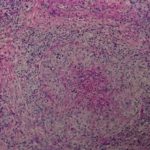 ,
,  ,
,  ,
, 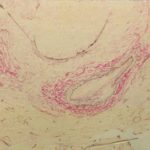 ,
, 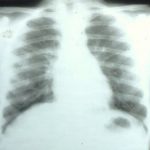 ,
,  ,
, 
-
Fluorescence microscopy was performed on the same sample as blankophor® staining according to Ruchel R. & Margraf S. 1993, Mycoses 36, 239-242. The artefactual staining of fibres and cellular elements is due to previous drying of the smear and recedes with time.
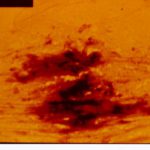
-
A needle biopsy of a solitary round infiltrate found near the thoracic wall in a patient with acute lymphoblastic leukaemia was gram-stained and then treated with an alkaline solution of the whitening agent Blankophor®.
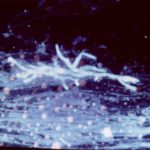
-
Medium power view (H&E) of cerebral abscess in which there are hyphae consistent with Aspergillus. Aspergillus fumigatus was grown from adjacent tissue.
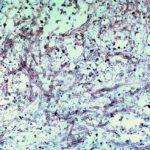
-
Medium power view (GMS) of kidney invaded by Aspergillus. The walls of the hyphae stain black. There are plentiful fungal hyphae within two glomeuli and there is also fungal invasion of adjacent cortical interstitial tissue.
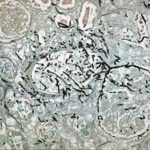
-
High power view (H&E) of uniform septate hyphae which show typical diclotomous branding characteristic of Aspergillus taken from mitral valve vegetation in a patient with disseminated aspergillosis. The hyphae are present within a background of fibrinous material.
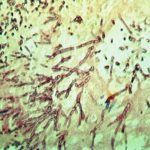
-
Medium power view (H&E) of lung tissue in patient with invasive pulmonary aspergillosis in which many of the fungal hyphae are seen in cross section.
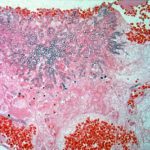
-
Medium power view of lung (H&E) in which there is invasion of lung parenchyma by hyphae characteristic of Aspergillus resulting in lung tissue infarction.
